
Are you struggling with your Stromanthe Triostar care? Would you like to know more about its water, temperature, and light needs? If so, keep reading to learn that and other Stromanthe Triostar care steps, from humidity and propagation to pruning and toxicity.
| Botanical Name (Latin Name/Scientific Name): | Stromanthe Sanguinea ‘Triostar’ |
| Common Name: | Stromanthe Triostar |
| Light: | medium light (750 lux – 3,000+ lux) |
| Watering: | when the top 2 inches of the soil dry out |
| Soil: | well-draining mix |
| Repotting: | once a year |
| Temperature: | 65°F to 75°F (18°C to 24°C) |
| Humidity: | adapts well to any humidity |
| Toxicity for Pets: | Non-toxic |
| Toxicity for Humans: | Non-toxic |
| Propagation: |
|
| Pruning: | Prune dead or diseased growth or when you want the plant to branch out |
Light Requirements
| Minimal amount of light: | 750 lux (75 FC) |
| Optimal amount of light: | 3,000+ lux (300+ FC) |
| Direct sun tolerance: | 1-2 hours |
| Category: | medium light |
Stromanthe Triostar light requirements are not too high, but the plant needs enough indirect light to thrive, and its not a fan of direct light/direct sun. Its minimal light requirement is 750 lux (75FC), but it would grow better with 3000 lux (300 FC). The more bright indirect light you provide, the plant will photosynthesize and grow faster, which is essential for the proper Triostar Stromanthe plant care.
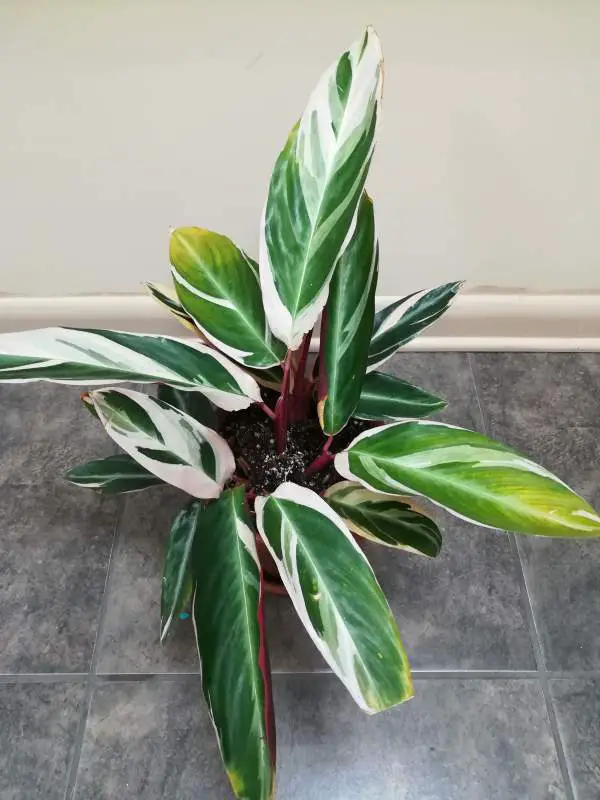
This decorative plant typically has colorful leaves, primarily hot pink; the variegation will be more prominent when exposed to more light
Another interesting thing about the light requirements of Stromanthe Triostar is that the more indirect light this plant gets, the variegation will be more prominent, so the topside on the leaves will be whiter, and the underside will be more purple.
Check out my Stromanthe Triostar timelapse video:
When it comes to sun exposure, Stromanthe Triostar can only handle an hour or two of direct sunlight, preferably in the early morning, as the morning sun is not too intense. You should avoid too much direct sun as the direct sunlight would cause sunburn, and the leaves would turn brown.
Water Needs
You should water Stromanthe Triostar when the top 2 inches of the soil dry out. There’s no strict watering schedule for adequate Stromanthe Triostar care, as the actual frequency will vary depending on the conditions in your home. Before watering, ensure to check the soil and verify that the top 2 inches are dry.
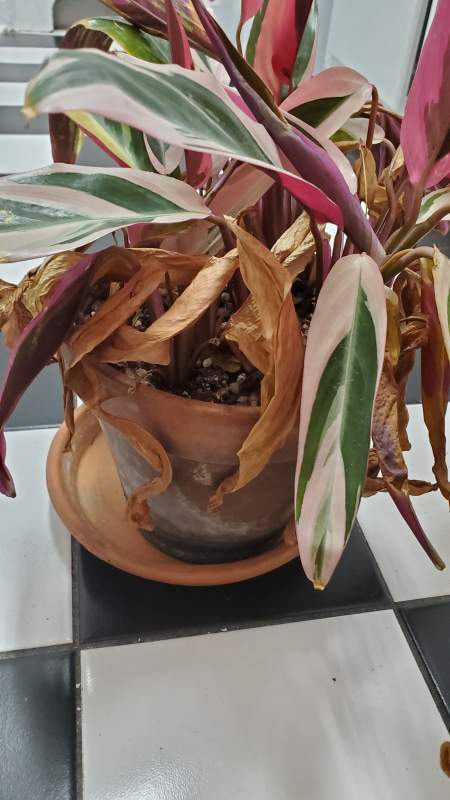
If you forget to water your Stromanthe Triostar, and the soil entirely dries out, the leaves will curl and eventually dry out
However, while you don’t want soggy soil, you must also prevent the soil from fully drying out. That’s because Stromanthe Triostar cannot tolerate fully dry soil. If the soil dries out completely, the plant’s leaves will start curling, and they will dry out.
Finding just the right amount of water for the proper Stromanthe Triostar care can be tricky, as too much water can lead to brown leaves, yellow leaves, root rot, and similar problems.
Humidity Needs
As for the Stromanthe Sanguinea Triostar humidity needs, the plant can adapt and grow in homes with low humidity without any issues. Although the Stromanthe Triostar plant is used to humid conditions in its natural habitat, like most houseplants, it can adjust to a low-humid environment easily.
However, you need to be aware of possible problems that come with humidity and Stromanthe Triostar plants. If the humidity is too low, you might encounter an issue with spider mites, while too high humidity can promote fungal infections.
Still, even these conditions are curable, so if you encounter spider mites, you can treat them with neem oil, which will also kill many other pests.
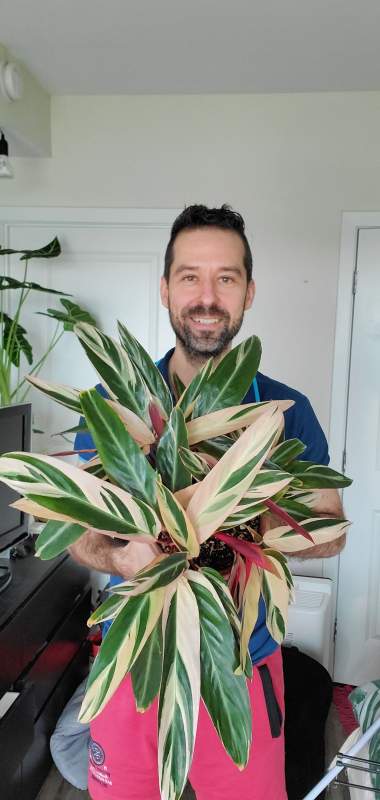
My Stromanthe Triostar plant grows healthy and beautiful because of the care it receives
Temperature Requirements
The optimal temperature for Stromanthe Sanguinea Triostar is between 65°F and 75°F (18°C and 24°C). This plant prefers temperatures above 65°F (18°C), but it can tolerate temperatures as low as 40°F (4°C). While most plants in the Marantaceae family cannot withstand temperatures below 60°F, Stromanthe Triostar is more durable.
It has good cold tolerance, so even when the temperatures drop below freezing temperatures the Stromanthe Triostar plant might still recover (at least the non-variegated version, the variegated one is less hardy).
Fertilizing
The fertilizing process for Triostar Stromanthe should occur periodically throughout the growing season. If you decide to fertilize, you can use a fertilizer like the Sill fertilizer. Make sure to follow instructions on the fertilizer, as there is such a thing as too much fertilizer. However, if you repot your Stromanthe Triostar annually and pot it in fresh soil, there’s no need to fertilize the plant at all.
Soil
The soil needs of Stromanthe Triostar are similar to other tropical plants, and the soil should be:
- Porous
- Well-draining
It should also provide a lot of oxygen to the Stromanthe Triostar plant, which is why, if you’re looking for a good potting mix that’s good straight out of the bag, use Mother Earth Groundswell Soil.
However, if you purchase a different potting mix, it’s best to amend it so that your Stromanthe Triostar care becomes successful. You can do that by mixing:
If you currently don’t have these amendments, you can use others to gain the same effect.
Repotting
To repot Stromanthe Triostar, you can either do full repotting or potting up. The potting up process involves moving the Stromanthe Triostar plant along with its root mass and soil into a larger container. Once you do that, you should fill the pot around the current mass with additional soil.
This is another essential step of the proper Stromanthe Triostar care, as the plant will grow better in fresh soil.
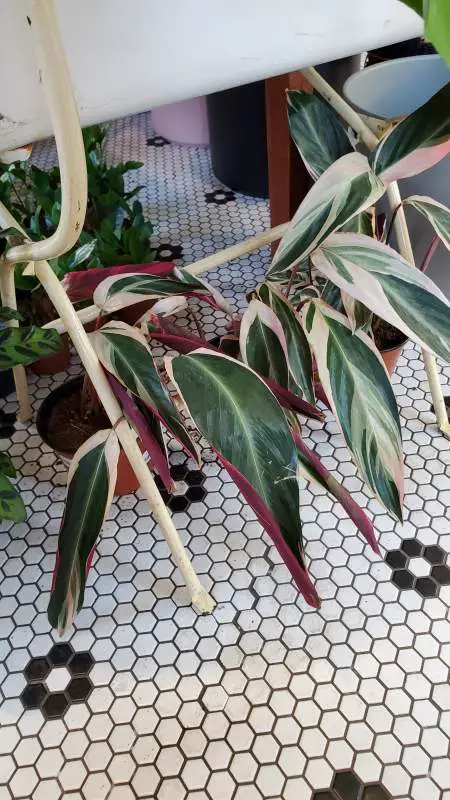
Plant parents with little experience should pot up their Stromanthe Triostar, while more experienced plant parents can fully repot it
On the other hand, if you want to do full repotting, you need to remove the soil entirely and prune dead, defective, or diseased roots. While this repotting process is better for the plant, it carries some risks for your Stromanthe Triostar plant, as you could unintentionally kill the plant.
Because of that, I advise that beginner plant parents stick to potting up, while more experienced plant parents can do full repotting.
This is how to repot a Stromanthe Sanguinea Triostar:
Toxicity To Humans
Stromanthe Sanguinea is not toxic to humans according to Ann King Filmer, Ph.D. Plant Scientist from the University of California, in the publication “Safe and Poisonous Garden Plants” from October 2012. Still, remember that this plant can cause vomiting problems in some people, so make sure you keep it away from children.
Toxicity To Pets
Stromanthe Triostar is not toxic to pets according to the American Society For The Prevention Of Cruelty To Animals (ASPCA). However, some animals can experience vomiting if they ingest it.
Pruning
To properly prune Stromanthe Triostar, remove the dead parts or brown of the leaves, or remove the whole leaf if necessary
- If the plant is diseased, remove the entire diseased area (typically the entire leaf)
- If there’s a severe pest infestation, you can remove the entire leaf
- If there are dead leaves, remove the whole leaf
- If there are brown edges, cut off the entire brown section or even cut into the healthy part to ensure you removed the full part of the brown edging
Remember only to prune the plant when and if you notice diseased, sick, dead, or damaged plant parts.
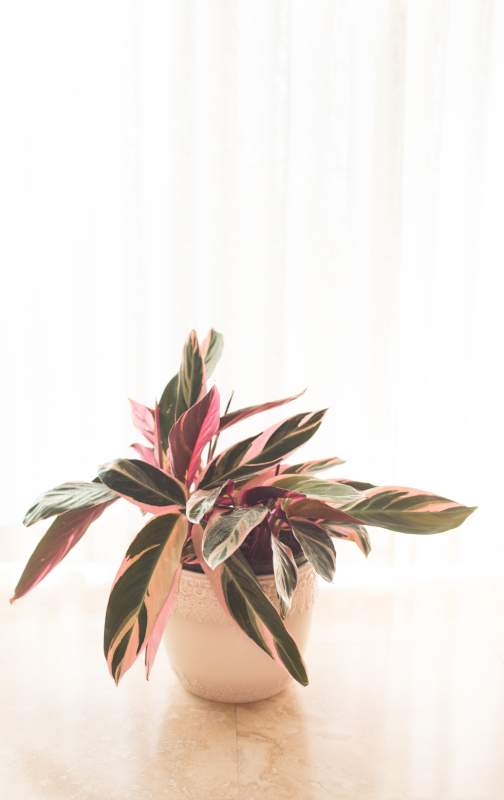
If you notice brown leaf edges, brown tips, or any other sign of plant damage, you can prune your Stromanthe Triostar
However, if your Stromanthe Triostar is healthy, there’s no need to prune it. Brown edges and dry leaves are common with this plant, and in those situations, you can prune it.
Propagation
Stromanthe Triostar propagation is done through division. As the plant grows, after a while, that same plant will get new clumps of leaves in the same pot. To propagate by division, you’ll need to:
- Take the whole plant out of the pot and remove the soil
- Separate the single clumps of leaves from the mother plant
- Plant them in a new decorative pot or nursery pot
FAQs about Stromanthe Triostar
How Do I Keep stromanthe Triostar Happy?
To keep the Stromanthe Triostar happy, provide it with bright indirect light (light over 3,000 lux) and water it when the top 2 inches of the soil dry out. This advice is the key for a happy and beautiful plant.
How Big Can A Triostar Get?
A Triostar plant can get up to 1.5-2.5 feet tall. Its stems can grow up to 5 feet tall and leaves up to 6-12 inch long.
Is Stromanthe Triostar Difficult?
Stromanthe Triostar isn’t difficult to care for. Make sure to provide the plant with proper growing conditions such as bright indirect light and proper watering (water once the top 2 inches of the soil dry out) and you will have a beautiful and happy plant.
Yours Truly,



Related Posts
Sansevieria Black Gold (Snake Plant Care GUIDE!)
Spathiphyllum Sensation (FULLY Explained!)
Alocasia Stingray Care